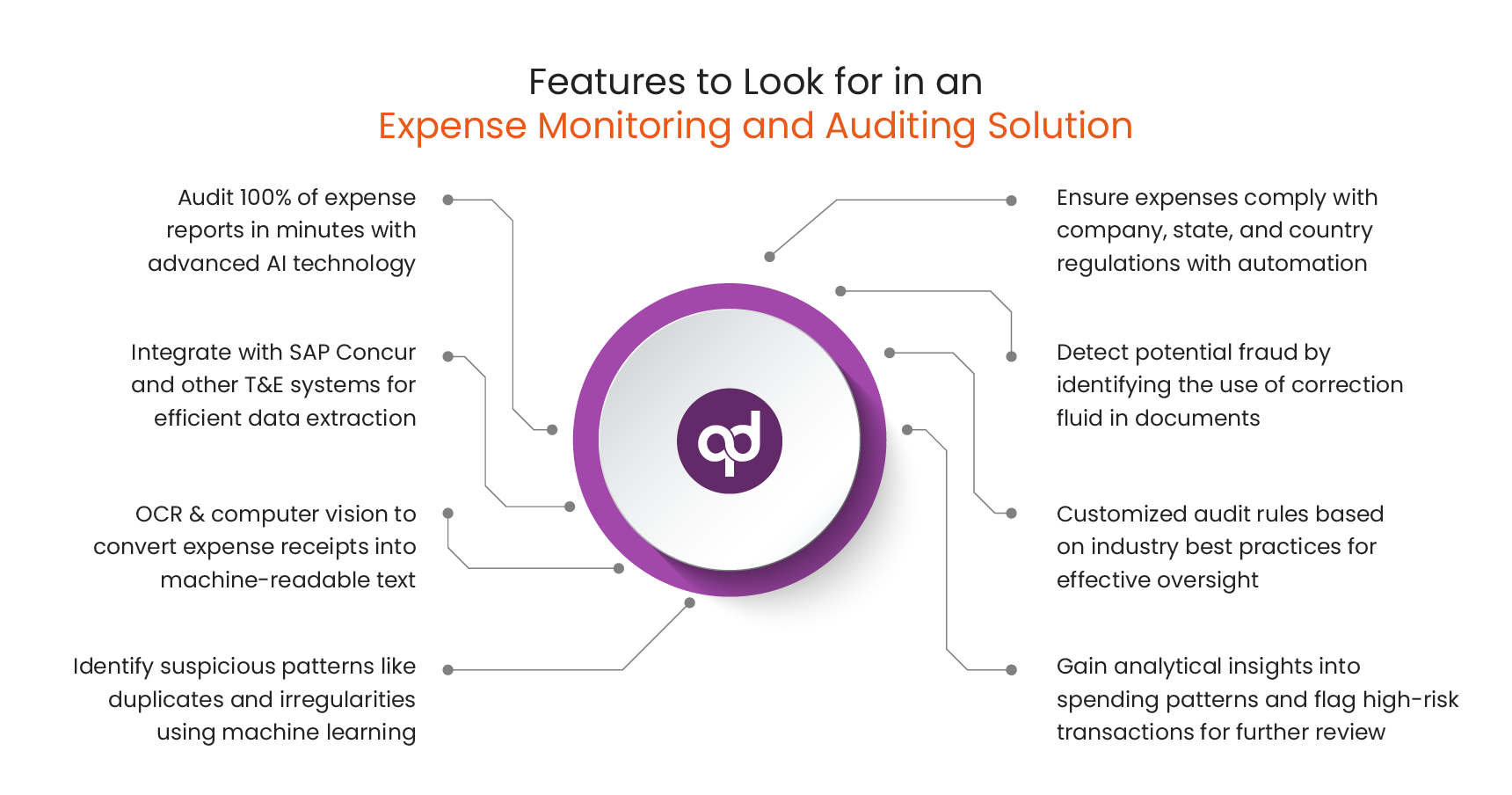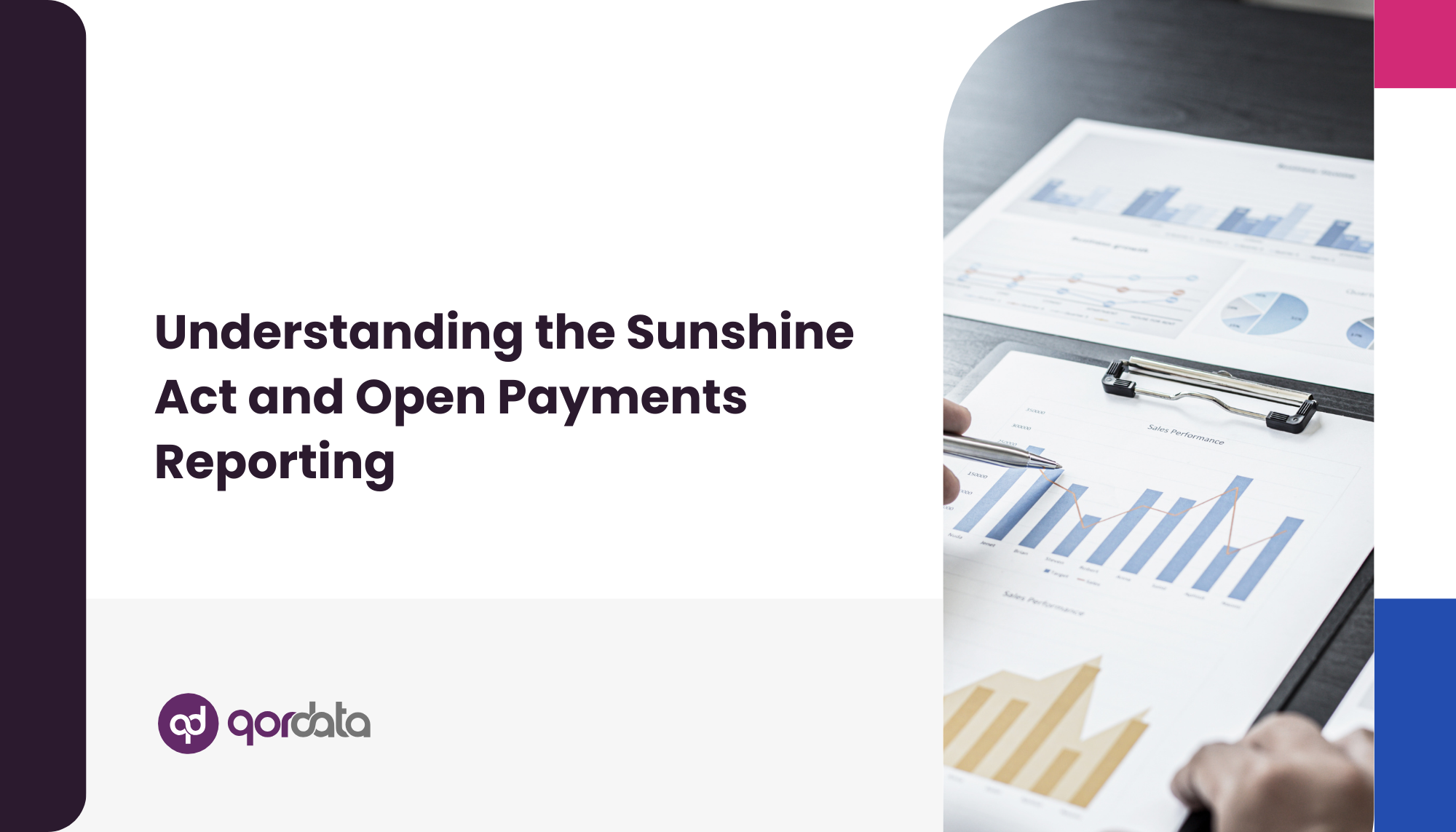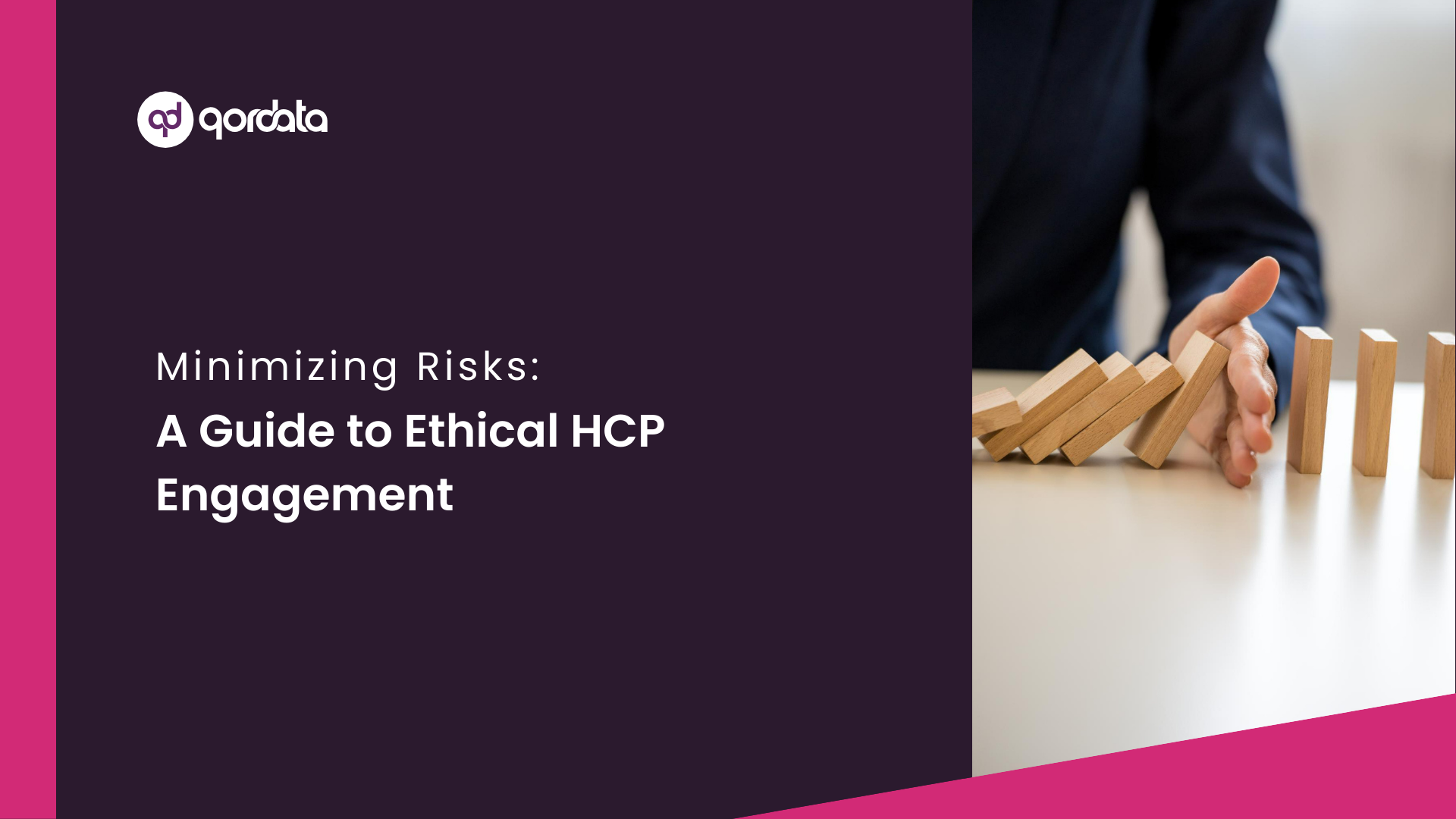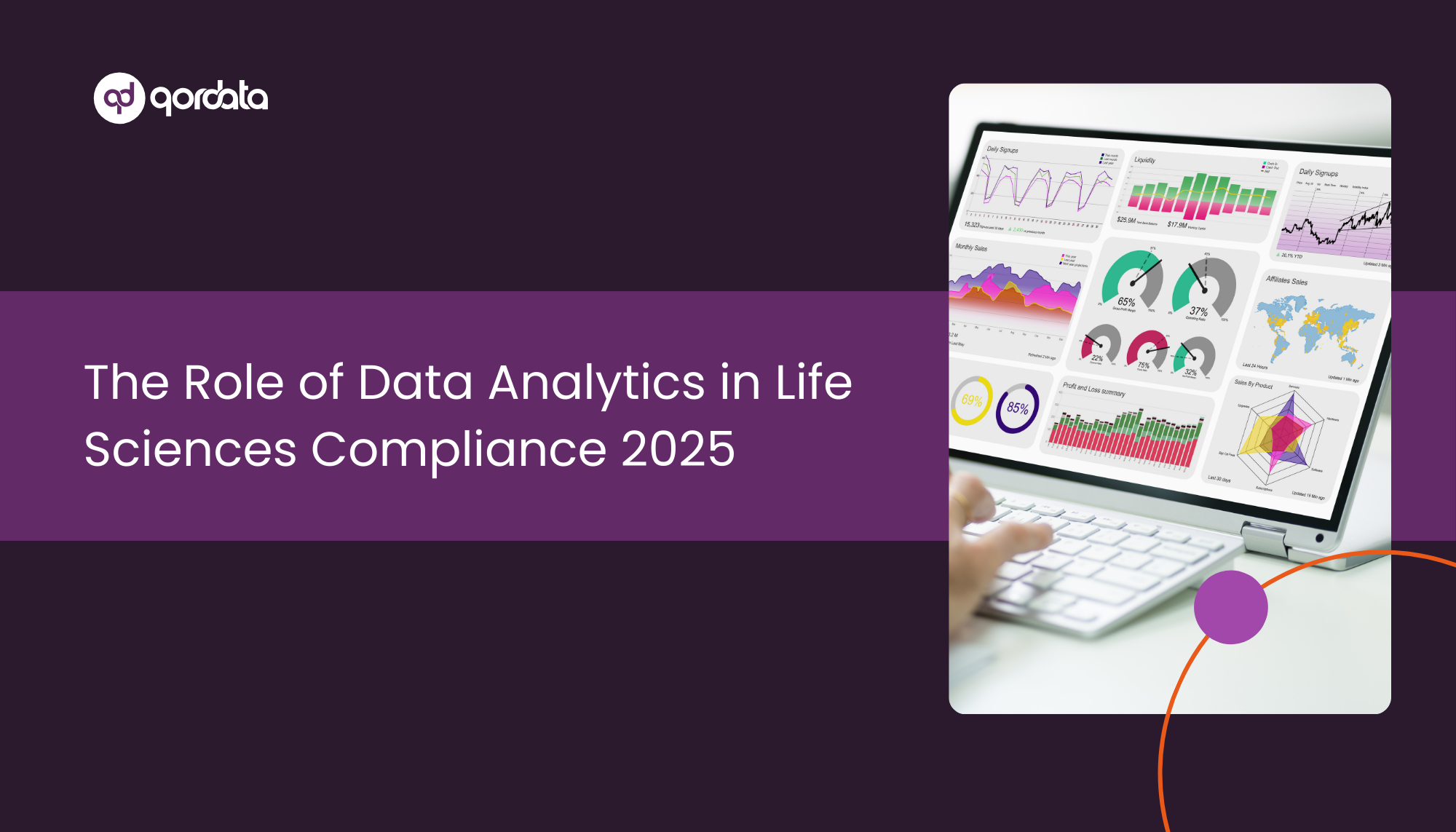With numerous expense monitoring and auditing software options available, selecting the right one for your organization’s specific needs can be a daunting task.
This blog serves as a guide to help you choose the best expense management software, enabling you to effectively and efficiently monitor and audit 100% of your expense data.
As a provider of an AI-powered expense monitoring and auditing solution, we have outlined six key criteria you can use to evaluate and compare expense management solutions.
Review the criteria below to make an informed decision on selecting an expense monitoring and auditing solution that meets your current needs and ensures regulatory compliance.
Comparison of the Leading Expense Monitoring and Auditing Solutions
To help you make an informed decision, we have compared the key features of qordata, AppZen, and SAP Concur.
Each solution offers unique capabilities, such as SAP Concur integration and advanced AI-driven features.
The table below provides a clear breakdown of their offerings to assist in areas like receipt processing, policy compliance, and fraud detection.
Through this comparison, you will be able to evaluate the distinct features of qordata, AppZen Expense Audit, and Concur Intelligent Audit.
| Feature | qordata | AppZen | SAP Concur |
| Audit Coverage | Leverages AI to conduct a 100% audit of expense reports within minutes. | Audits 100% of expenses prepayment, auto-approves spend. | Audits expenses with a combination of AI and human auditors. |
| Integration | Offers SAP Concur Integration and connects with other T&E systems. | Works with multiple systems; integrates apps through AppZen Finance AppStore. | Integrated with Concur Travel and Concur Expense. |
| Receipt Processing | OCR and computer vision to convert receipts into machine-readable text. | Translates foreign language receipts into English; extracts and auto-approves line items from receipts. | Human auditors validate receipts to match expenses (date, amount, vendor, etc.). |
| Anomaly Detection | Uses machine learning to detect anomalies in sign-in sheets (white-outs, incomplete forms, same-person signatures). | Detects out-of-policy purchases, mismatched expense lines, duplicates, and unauthorized purchases. | AI and auditors identify misuse, fraud, and non-compliance. |
| Policy Compliance | Checks expenses against company, state, and country policies. | Enforces nuanced expense policies, understands natural language terms, and detects policy breaches. | Ensures compliance with tax, regulatory, and policy requirements. |
| Risk Identification | Identifies risk patterns and flags for further monitoring. | Identifies suspicious attendees, dual-use merchants, and high-risk spend patterns. | Identifies trends and provides regular consulting sessions to mitigate risks. |
| Analytics | Provides comprehensive insights and global coverage. | Custom dashboards and benchmarking metrics for T&E program improvements. | Provides detailed audit analytics and regular trend reviews. |
| Global Coverage | Global coverage. | Multilingual auditing, supporting 40+ languages, with benchmarks from industry peers. | Global auditor team offering support in multiple languages. |
| Customizability | Built-in, configurable audit rules based on best practices. | Custom AI models and workflows to automate unique policies and enhance performance. | Custom audit settings to meet unique business requirements. |
| Fraud Detection | Uses machine learning for anomaly detection and fraudulent sign-in sheets. | Detects fraudulent transactions via AI-based matching and searching external sources (e.g., merchant lists). | Identifies fraudulent transactions using AI and human auditing. |
| Expense Reconciliation | Reconciles expense reports against sign-in sheets and receipts. | Matches duplicate expenses across different formats (receipts, P-Card, etc.). | Matches receipts to expenses and identifies exceptions. |
| Additional Features | Flags non-conducive venues for events, and ML-based fraud detection for sign-in sheets. | Prebuilt apps for sales tax, Fapiao, and credit card compliance. Detects suspicious merchants and hidden charges. | Human auditors manage exceptions and offer additional support for VAT management. |
Criteria #1: Current Process Assessment
The first step starts from within, where compliance and finance officers must assess their current processes and systems, identify gaps, and begin looking for solutions that address those gaps with specific features and capabilities.
The first step starts from within where compliance and finance officers must assess their current finance processes and systems in place, determine gaps, and then start looking out for solutions that address those gaps with certain features and capabilities.
Below are some of the critical questions to consider in this phase:
– Assess Current Processes:
- How does the organization currently handle expense monitoring and auditing?
- The level of expense monitoring and auditing digitalization or automation?
- What are the current gaps and improvements required to monitor and audit 100% expense data?
- How long does it take to conduct a full audit of expense data?
– Identify Gaps:
- Identify current system lacking, process gaps, and potential challenges.
An example of this can be identifying the validity of invoices being submitted, manual expense auditing or detecting whiteouts, duplicate expenses, spending patterns, and more.
– Stakeholder Feedback:
- What do the upper management such as the chief compliance officer, chief finance officer, head of compliance monitoring, compliance operations, and others think about the current processes?
- Is the internal team facing any challenges, inefficiencies, or hurdles?
Document this information to get insights into areas for improvement and the features necessary for enhancing the performance of your internal departments.
Criteria #2: Adaptability & Integrations
Life sciences companies generate vast amounts of expense data annually, and this volume is projected to increase steadily in the coming years.
This is why adaptability and scalability are essential when selecting an expense management solution.
A study reveals that:
- Specialty medicines are projected to account for over 40% of global spending by 2028.
- It costs an average of $2.3 billion to bring a new drug from discovery to market.
- The top 20 global life sciences companies spent $139 billion on R&D in 2022.
Thus, the second criterion to consider when selecting an expense monitoring and auditing solution is adaptability and integration capabilities.
Adaptability ensures the solution scales with your organization, meeting growing demands, while integration allows connectivity across existing T&E systems like Concur Intelligent Audit or Concur Expense Audit, enhancing overall efficiency.
Consider the following while evaluating the adaptability and integration capabilities of an expense monitoring and auditing solution like Appzen expense audit:
- Integration: Does the solution offer integration options, such as pre-built connectors or integration with existing T&E systems?
Robust integration can facilitate smoother data flow between T&E systems.
- Compatibility: Will the solution integrate with your current CRM, ERP, and finance systems, such as QuickBooks or SAP Concur?
This ensures that your teams can work within familiar platforms, minimizing disruptions.
- Ecosystem of Extensions: Does the expense monitoring and auditing software provider maintain a large ecosystem of solution and service extensions?
A provider with a strong network of third-party technology, service partners and offerings can offer additional capabilities and support.
qordata’s Expense Monitoring and Auditing
- Includes SAP Concur integration to efficiently extract reports.
- Integrates with existing T&E systems and SAP Concur.
Concur Intelligent Audit
- Offers integration options, including pre-built connectors for T&E systems.
- Seamlessly integrates with CRM and ERP systems like SAP Concur.
AppZen Expense Audit
- Provides integration options but may require custom setups for some T&E systems.
- Integrates with platforms like QuickBooks and SAP Concur, though integration may vary.
Our expense monitoring and auditing solution integrates seamlessly with SAP Concur and other T&E systems, ensuring that data flows smoothly across platforms while offering capabilities designed to reduce the risk of non-compliance.
Criteria #3: Technology Advancements
The rapidly evolving technological landscape has introduced emerging technologies such as artificial intelligence, machine learning, computer vision, and more.
Integrating these technologies with an expense monitoring and auditing solution enables comprehensive and intelligent auditing of expense data, allowing life sciences companies to detect potential violations and anomalies, and mitigate risks.
This also empowers compliance officers to ensure regulatory compliance effectively and efficiently, enhancing overall accuracy and risk management.
Consider the following factors when determining how advanced an expense management solution is:
- Track Record: Is the solution provider at the forefront of technological innovation in compliance?
Review their history and development timeline to assess their commitment to continuous improvement.
- Frequency of Updates: How often are product updates released?
You can verify this by checking the providers news page. Regular updates demonstrate a commitment to advancements and responsiveness to user feedback.
qordata Expense Monitoring and Auditing
- qordata is committed to technological innovation, utilizing AI, ML, OCR, and computer vision technologies for advanced expense monitoring and auditing.
- Product updates are released consistently to improve functionalities and adapt to industry needs.
Concur Intelligent Audit
- Concur expense audit solution features the forefront of technological innovation in compliance, leveraging AI and machine learning.
- Regular product updates are released, ensuring continuous improvement and feature enhancements.
AppZen Expense Audit
- Recognized for its innovative approach to compliance through advanced AI-driven solutions.
- Frequent updates are provided to enhance features and maintain compliance with evolving regulations.
Criteria #4: Security Level
With increasing concerns about data breaches and privacy, security standards and protocols are of high importance for life sciences companies.
Involve your IT team in reviewing the security protocols offered by the expense management solution provider. Ideally, you and the IT team can look for:
- Does the solution support Single Sign-On (SSO) for easy and secure access?
- Ensure the platform uses robust encryption to protect sensitive information.
- See if the provider undergoes regular security audits and holds industry accreditations such as ISO 27001 or SOC 2.
- Does the solution help in adhering to global privacy standards, including GDPR, CCPA, and more?
qordata complies with ISO 27001 and SOC Type 2 standards, enabling us to ensure robust security for your organization’s compliance or expense data.
Criteria #5: Round the Clock Support
The level of support provided by the solution provider can significantly impact your organization’s experience. To determine their support capabilities, look for the following:
- 24/7 Support: Look for expense management solutions that provide around-the-clock support via phone, chat, and email.
If your company’s operations are global, the support should be available in multiple languages to accommodate diverse teams.
- Knowledge Base: See their knowledge base which should involve guides, forums, and on-demand webinars that can empower your internal team to resolve issues independently.
- On-Demand Support: Consider whether the provider offers on-call support for your employees which can be invaluable for addressing urgent questions or concerns.
Criteria #6: Industry Recognition
With numerous providers entering the expense monitoring and auditing market, industry recognition of the solution provider is an essential criterion to consider.
To assess this, you need to evaluate:
- Years in the Market: How long has the provider been in business, specifically in providing automated or AI-powered expense management solutions?
Longevity can be an indicator of reliability and expertise.
- Clientele: How many clients does the solution have, and in which countries? A broad user base can reflect the solution’s effectiveness across various demographics.
- Ratings and Reviews: Is the expense management solution highly rated by users? Look for reviews or case studies that provide insights into real user experiences, implementations, and outcomes.
- Industry Recognition: See any industry accolades or awards. Recent awards can signify a commitment to excellence and success as an expense management solution provider.
Discover how a leading pharmaceutical company transformed its compliance processes by leveraging qordata’s AI-driven Expense Monitoring and Auditing solution.
Why Do You Need an Expense Monitoring and Auditing Solution?
An Expense Monitoring and Auditing Solution is crucial for organizations aiming to enhance compliance and reduce fraud risks.
As regulations become more complex and the volume of expense reports grows, manual auditing is no longer sufficient. Automating these processes saves time and significantly lowers the risk of human error.
Comprehensive expense analytics provide visibility that empowers organizations to make informed decisions.
The proactive approach not only protects against financial losses due to fraud but also fosters accountability among employees, streamlining operations and improving financial and compliance processes.
Below are some reasons why life sciences companies today need an expense monitoring and auditing solution:
- Conduct AI-driven audits of 100% of your expense reports within minutes.
- Connect with existing T&E systems, such as Concur, for efficient report extraction.
- Leverage OCR and Computer Vision to convert receipts into machine-readable text.
- Use automation to match expense reports with sign-in sheets and receipts for accuracy.
- Machine learning identifies anomalies and inconsistencies, allowing your organization to focus on high-risk transactions.
- Ensure adherence to regulations, minimizing non-compliance risks.
- Integrate industry best practices in expense monitoring and auditing with configurable rules.
- Detect and flag risk patterns for further monitoring.
- Provide in-depth analytics to support decision-making.
- Consolidate high-risk expenses for efficient compliance management.
Conclusion
Choosing the right expense management software requires careful consideration of these six essential criteria.
By focusing on features, integration capabilities, innovation, security, support, and reputation, you can select a solution that not only meets your current needs but also adapts to future challenges.
Incorporating these six criteria into your evaluation process will help you make an informed decision that drives your organization toward greater efficiency and cost savings.
Other Relevant Reads:




